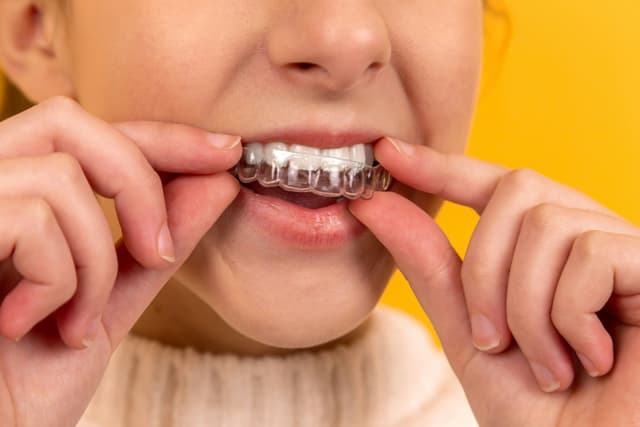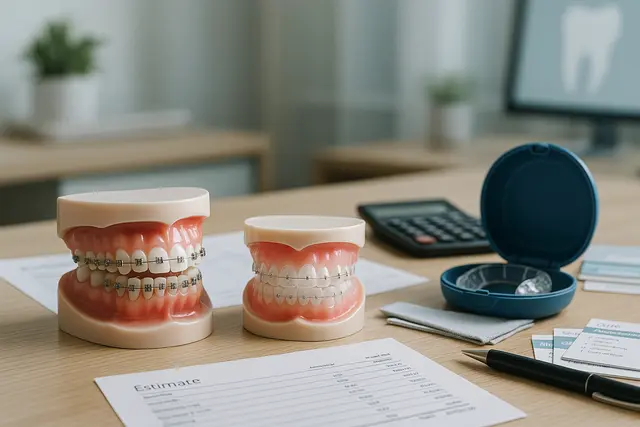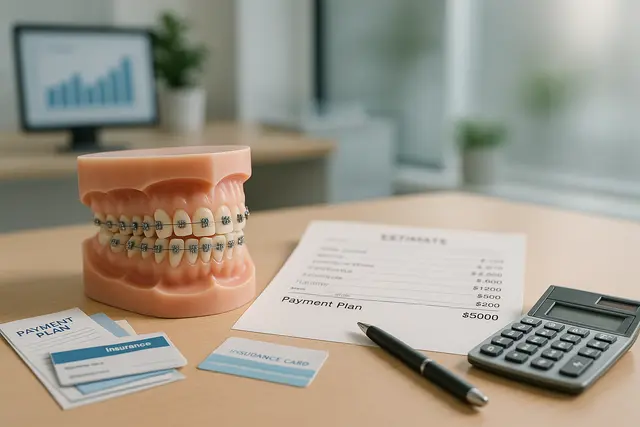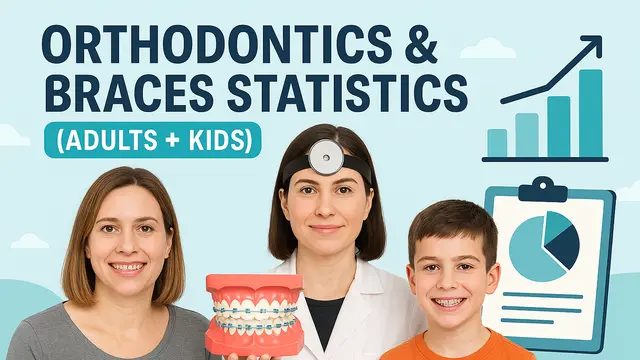Orthodontics
6 min read
Feb 02, 2025
How Invisalign Works: The Invisible Orthodontic Solution
Invisalign offers a discreet way to straighten teeth using clear, removable aligners. This orthodontic treatment has revolutionized traditional approaches to correcting crowding, gaps, and misaligned bites.

You’ve probably heard the hype around Invisalign—and maybe you’ve even caught a glimpse of someone smiling mid-sentence and wondered, Are they wearing something on their teeth? Well, they probably were. That’s the beauty of it. Invisalign has revolutionized the world of orthodontics by offering a way to straighten your teeth that’s virtually invisible, comfortable, and way less awkward than sporting a mouthful of metal.
But how exactly does Invisalign work? What’s behind this subtle smile makeover that’s taken over Instagram feeds and dental offices across the country? Whether you're researching teeth straightening options for yourself or someone in your family, this article breaks down the entire Invisalign treatment process in a way that actually makes sense—and maybe even makes you smile.
Invisalign Work: The Basics
Invisalign is an orthodontic treatment that uses clear aligners to move your teeth into their ideal positions. Unlike traditional braces that rely on brackets, wires, and constant tightening appointments, Invisalign aligners are made from a flexible plastic material that fits snugly over your teeth. Each aligner in the series is designed to gradually shift your teeth just a little bit at a time.
So yes, Invisalign works by using a set of aligners that apply controlled pressure to move the teeth. The magic isn’t just in the plastic—it’s in the precise digital treatment planning that guides each stage of your journey.
Let’s Talk About Braces (and Why People Still Use Them)
Before we get too starry-eyed over Invisalign, it’s worth giving traditional braces their due. Braces have been around for centuries (yes, really), and they’re still a solid choice for certain complex cases. Metal braces use brackets glued to your teeth and wires that apply pressure to slowly move the teeth over time. They’re tough, effective, and often the go-to solution for major alignment issues.
But let’s be honest: they’re not exactly discreet. That’s where Invisalign braces offer a modern, aesthetic alternative.
Tooth Movement, Simplified
Each Invisalign aligner is custom-made to fit your teeth and move them just enough. When you wear a new set of aligners, it might feel tight at first—this is good! It means it’s working. That pressure is gently guiding the position of your teeth, which is how Invisalign moves them. Over time, each set of aligners continues the work, and you get closer and closer to that straighter smile.
Invisalign uses a sequence of these aligners to handle different stages of tooth movement. It’s like leveling up your smile one step at a time.
Straighten Your Teeth Without Sacrificing Style
Here’s the big reason people fall in love with the idea of Invisalign: it lets you straighten your teeth without the visual impact of traditional braces. The aligners are virtually invisible. You can smile in selfies, go on dates, give work presentations—without anyone even realizing you're mid-treatment.
So, How Much Does Invisalign Really Cost?
We get it—orthodontic work isn’t pocket change. The cost of Invisalign treatment varies depending on how complex your case is, how long you’ll need aligners, and which Invisalign provider you choose. On average, the Invisalign cost falls somewhere between $3,000 and $8,000.
That’s a range, yes, but it includes a customized treatment plan, the aligners themselves, and your visits throughout the treatment. Some insurance plans help with the cost, and many providers offer payment plans.
Invisalign Aligners: What Are They Made Of?
Invisalign aligners are made from a patented thermoplastic material called SmartTrack. It’s flexible, comfortable, and designed to apply gentle but effective force to shift your teeth. These aligners are also BPA-free, so they’re safe to keep in your mouth for hours at a time.
Each set of aligners is crafted to fit snugly over your teeth, and because they’re clear, they’re discreet. You’ll wear them for 20 to 22 hours a day—yes, you can (and should) take them out to brush and floss your teeth, eat, and drink anything besides water.
The Invisalign Treatment Experience
Your Invisalign treatment begins with a visit to an Invisalign provider. They’ll take a 3D scan of your teeth (no goopy molds—hallelujah) and use treatment planning software to map out your smile transformation from start to finish. This customized treatment plan shows exactly how your teeth will move and how long it will take.
After that, your aligners arrive in the mail or your orthodontist's office, and your Invisalign journey officially begins.
Planning It Out: The Customized Treatment Plan
Your treatment plan is the backbone of the entire Invisalign process. This plan guides every single aligner in the set, telling it exactly which teeth to move, how far, and when. Each set of aligners targets specific teeth, applying just the right amount of force to keep things moving in the right direction.
Throughout your Invisalign treatment, your orthodontist might use Invisalign attachments—small, tooth-colored bumps bonded to your teeth—to help the aligners grip better and make certain tooth movements more precise.
Teeth Straightening With Tech
Invisalign isn’t just plastic trays. It’s high-tech orthodontics in a sleek package. The treatment planning software used behind Invisalign allows orthodontists to see the movement of your teeth at each stage of the process. This precision is part of what makes Invisalign treatment different from traditional braces.
The Invisalign technology ensures that every aligner fits perfectly and does its job efficiently. That means fewer surprises and a straighter smile on schedule.
Invisalign Process: Step by Step
Here’s how the Invisalign process usually works:
Consultation: Meet with an Invisalign provider to determine if Invisalign is the right treatment option for you.
3D Scan: Get a model of your teeth with digital imaging.
Treatment Planning: A customized treatment plan is created using treatment planning software.
Aligners Arrive: Your set of aligners is delivered, and your Invisalign journey begins.
Wearing the Aligners: Use clear aligners for at least 20 hours a day. Remove only for eating, drinking, and brushing.
Check-ins: Regular visits with your provider ensure your teeth are shifting on schedule.
Final Results: After the last aligner, you’ll receive retainers to keep your teeth straight.
Treatment Cost vs. Value
When weighing Invisalign vs braces, it’s not just about the treatment cost—it’s about comfort, convenience, and confidence. Invisalign may be slightly more expensive than traditional braces, but for many, the freedom and subtlety it offers are well worth the price.
Throughout the treatment process, you'll notice not just physical changes but emotional ones, too. A straighter smile can boost self-esteem, improve oral health, and make social interactions feel less self-conscious.
Behind Invisalign’s Success
The behind Invisalign approach is really about blending science, design, and human experience. It’s orthodontics without the bulk, the wires, or the teenage flashbacks. It’s about giving people a straighter smile in a way that works with their lives, not against them.
And because Invisalign aligners are designed using cutting-edge digital tools, every step of your treatment is intentional.
Start Your Invisalign Journey
So, if you’ve been staring at your teeth in selfies or covering your mouth when you laugh, maybe it’s time to consider Invisalign. Whether you're dealing with crowding, gaps, or a bite that’s just a little off, Invisalign offers a modern way to get results.
The way to straighten your teeth has changed—and with Invisalign, it's smarter, smoother, and practically invisible. When you're ready to smile with Invisalign aligners, you'll be stepping into something more than a treatment. You’ll be stepping into a new smile.
Teeth Straightening Options: Why Choose Invisalign?
There are many benefits of Invisalign, especially for those looking for a discreet treatment option. It’s removable, easier to keep clean, and less likely to cause irritation compared to traditional metal braces.
Plus, Invisalign offers more flexibility—no food restrictions (hello popcorn), and brushing and flossing is way easier without brackets in the way.
What Makes Invisalign Treatment Different?
The effectiveness of Invisalign comes down to how personalized it is. Every aligner is built for your mouth. The movement of your teeth is carefully calculated. And the technology keeps your treatment on track from start to finish.
This isn’t a one-size-fits-all kind of deal. Invisalign is suitable for teens and adults alike, offering a way to align your teeth without dramatically altering your appearance or lifestyle.
How Long Does the Treatment Take?
Your total treatment time depends on your case, but most people finish their Invisalign treatment in 12 to 18 months. Some simpler cases wrap up in as little as six months, while more complex ones can take longer.
And yes, the aligners are worn in a specific sequence. You’ll switch to a new set of aligners every one to two weeks, each one bringing you closer to the final alignment of your teeth.
Read Next
Related Posts

Orthodontics
Retainer That Looks like Braces: Benefits for Long-Term Alignment
A retainer might not get as much attention as braces, but it plays a crucial role in maintaining your smile after orthodontic treatment. Whether you're new to retainers or curious about the type that looks like braces, understanding their purpose and benefits is key to keeping your teeth aligned for the long haul.
6 min read
Sep 15, 2025

Orthodontics
How Much Are Metal Braces? Cost Comparison With Other Options
Thinking about getting braces but overwhelmed by the cost? You’re not alone. Orthodontic treatment can be a major investment, and understanding the different price points, from metal braces to clear aligners, can help you make a smart, confident decision.
5 min read
Sep 15, 2025

Orthodontics
Orthodontics & Braces Statistics (Adults + Kids)
Orthodontics has transformed from a niche medical service for teenagers into a booming sector that spans all ages. Today, both adults and children seek orthodontic treatment to improve their smiles, fix bite issues, and boost self-confidence.
4 min read
Aug 21, 2025
Don’t have time to research every dentist around you?
See why 30k+ patients trusted us